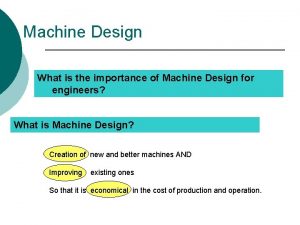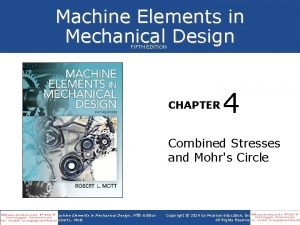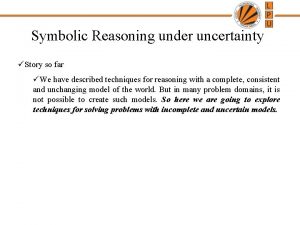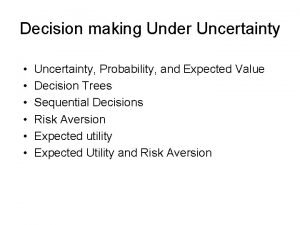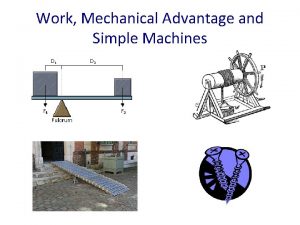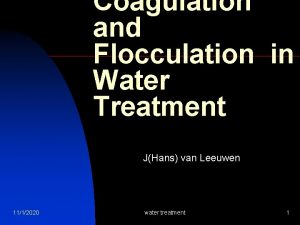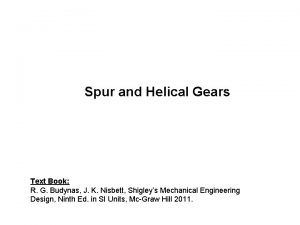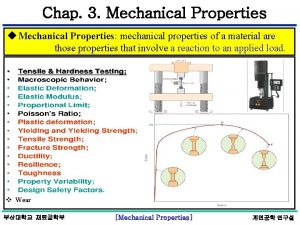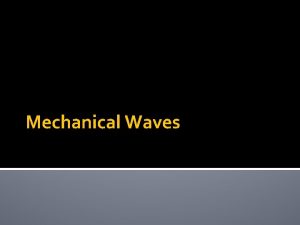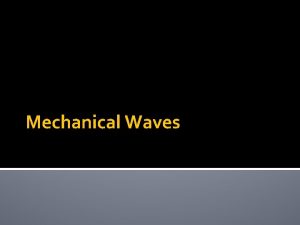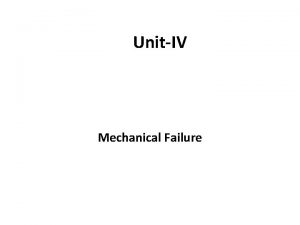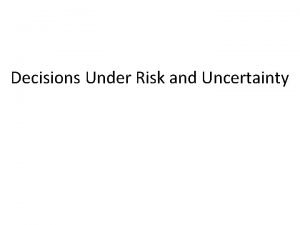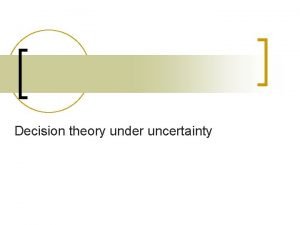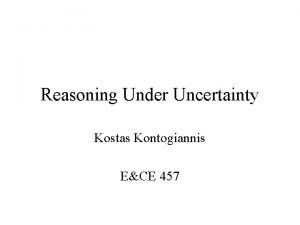Machine Design Under Uncertainty Outline Uncertainty in mechanical


























- Slides: 26

Machine Design Under Uncertainty

Outline • • • Uncertainty in mechanical components Why consider uncertainty Basics of uncertainty Uncertainty analysis for machine design Examples Conclusions 2

Uncertainty in Mechanical Components • 3

Where Does Uncertainty Come From? • Manufacturing impression – Dimensions of a component – Material properties • Environment – Loading – Temperature – Different users 4

Why Consider Uncertainty? • We know the true solution. • We know the effect of uncertainty. • We can make more reliable decisions. 5

How Do We Model Uncertainty? • We use probability distributions to model parameters with uncertainty. 6

Probability Distribution • With more samples, we can draw a histogram. 7

Normal Distribution • 8

• It indicates how data spread around the mean. • It is always non-negative. • High std means – High dispersion – High uncertainty – High risk 9

More Than One Random Variables • 10

Reliability • 11

First Order Second Moment Method (FOSM) • 12

Monte Carlo Simulation (MCS)* A sampling-based simulation method Distributions of input variables Step 1: Sampling of random variables Generating samples of random variables Samples of input variables Step 2: Numerical Experimentation Evaluating performance function Analysis Model Samples of output variables Step 3: Statistic Analysis on model output Extracting probabilistic information Probabilistic characteristics of output variables *This topic is optional. 13

Step 1: Sampling on random variables

Step 2: Obtain Samples of Output

Step 3: Statistic Analysis on output

FORM vs MCS • FORM is more efficient • FORM may not be accurate when a limit-state function is highly nonlinear • MCS is very accurate if the sample size is sufficiently large • MCS is not efficient 17

Example - FOSM • 18

Example - FOSM • 19

Example - FOSM • 20

Example - MCS • 21

100 and 1000 Simulations

1 e 5 Simulations • More simulations, More accurate result

Reliability –Based Design (RBD) Design without considering uncertainty: Low reliability Nominal design point x 2 Failure Region Safe Region x 1 Actual design points Design with considering uncertainty: high reliability x 2 Failure Region Safe Region x 1 24

RBD • RBD ensures that a design has the probability of failure less than an acceptable level, and • therefore ensures that events that lead to catastrophe are extremely unlikely. • RBD is achieved by maximizing cost and maintaining reliability at a required level. 25

Conclusions • For important mechanical components in important applications, • a factor of safety may not be sufficient to account for uncertainties; • it is imperative to consider reliability. • Uncertainty can be modeled probabilistically. • Reliability can be estimated by FOSM and MCS. 26
 Importance of machine design in mechanical engineering
Importance of machine design in mechanical engineering Machine elements in mechanical design 5th edition
Machine elements in mechanical design 5th edition Machine elements in mechanical design
Machine elements in mechanical design Reiters
Reiters Uncertainity in decision making
Uncertainity in decision making Decision-making under uncertainty
Decision-making under uncertainty Capital budgeting under uncertainty
Capital budgeting under uncertainty Expected profit under uncertainty
Expected profit under uncertainty Actual mechanical advantage vs ideal mechanical advantage
Actual mechanical advantage vs ideal mechanical advantage Example of topic outline and sentence outline
Example of topic outline and sentence outline Parts of sewing machine under the bed
Parts of sewing machine under the bed How to calculate experimental uncertainty
How to calculate experimental uncertainty Wheel and axle mechanical advantage
Wheel and axle mechanical advantage Mechanical turing machine
Mechanical turing machine Learning outcomes generator
Learning outcomes generator How does mechanical advantage work
How does mechanical advantage work Different types of pulleys
Different types of pulleys Finite state machine vending machine example
Finite state machine vending machine example Mealy moore
Mealy moore Mealy to moore conversion
Mealy to moore conversion Chapter 10 energy work and simple machines answer key
Chapter 10 energy work and simple machines answer key Designspark.com
Designspark.com Mechanical flocculator
Mechanical flocculator Mechanical engineering design book
Mechanical engineering design book Mechanical considerations of transmission line
Mechanical considerations of transmission line Visual balance floral design
Visual balance floral design Mechanical housing design
Mechanical housing design
